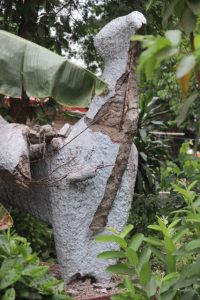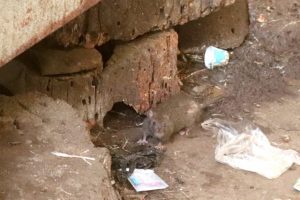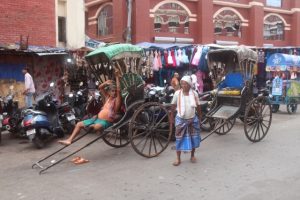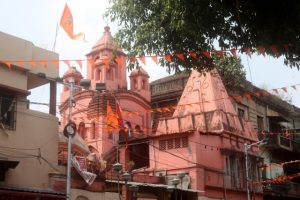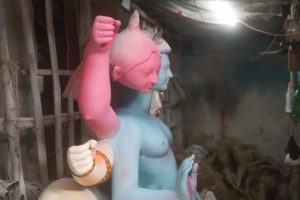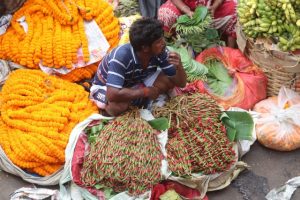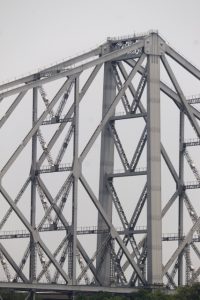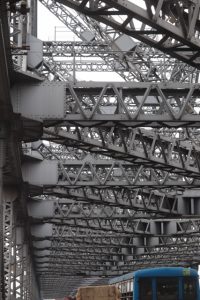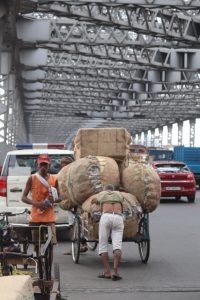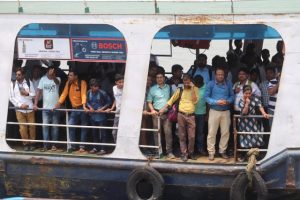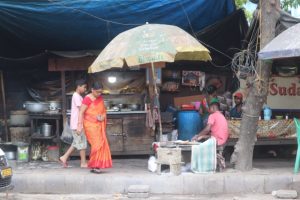Another thing we have always associated with Calcutta is its artistic credentials. All the artists we knew, and knew of, 20 years ago, were Bengali, so it cannot be other than that Calcutta is the capital of Indian art, at least its modern and contemporary art.
The first signs are indeed positive, I discover the KMOMA, the Kolkata Museum of Modern Art, no less than nine stories, and a fabulous building. At least, the artist’s rendition looks fabulous, but as it turns out the construction, started in 2013, hasn’t been finished yet. Or maybe it hasn’t even started.
The Academy
But there must be many other museums and galleries dedicated to the arts, in a city like Calcutta. So what better place to begin than at the Academy of Fine Arts. The building, close to the Saint Paul’s cathedral, is a bit run down, which is exemplified by the sculptures in the garden, many of which are damaged.
It is three stories high, but the main collection, of paintings, is on the first floor, and is pretty small. It starts with a series of paintings by Rabindranath Tagore, which is not exactly my style. And in the adjoining room there are another 30-40 paintings, by Indian artists, that are also mostly not my style, mostly based on very traditional Indian themes – no searching for the edges, as one would expect from modern and contemporary art. The two rooms downstairs are filled with work of young and upcoming artists, and look very much like a sales exhibition rather than a museum. Some of it is mildly attractive.
The Galleries
A little further away is the Birla Academy of Art and Culture, an institution established in 1967 to encourage and help young artists. The main event here is the 58th Annual Exhibition, indeed a recurring initiative to promote emerging artists. The selection is a little wider than at the Academy of Fine Arts, but much of the work is, in my eyes, a bit tacky, not of great artistic value. The curator could have been a little more stringent, or perhaps the supply was simply not good enough. Some of the photographs that are being exhibited are not even sharp, like that of the Kangchenjunga – the one I showed you earlier is a better picture!
There are lots of commercial galleries in Calcutta, but here, too, we have not been very successful. One we simply couldn’t find, another was rather far away, and the third, the CIMA gallery, had just started a solo exhibition of Shakila, a self-made artist. In itself a nice collection, but it deprives us once again of a kind of an overview of works of Bengal-based artists.
In the end the best experience is at the Ahuja Museum of Art, which displays a small part of the private collection of Mr Ahuja, who pays for the large room and for the coffee that is offered to visitors. Here we finally see a broad variation of quality modern art, most of it presumably Indian – there is no catalogue, and no cards at the individual works. And finding out later is also difficult, because, as everywhere, in the museums and the commercial galleries, photography is strictly forbidden.
Hogg’s Market
In fact, Calcutta’s contemporary art, its more playful exponents thereof, can be found right in the city centre, outside Hogg market. The market itself is mostly inside the red-brick building, dating from 1874, where slaughtered meat and poultry competes with living rats that squirrel away in between the stalls. It is big, but not very colourful, and a far cry from earlier markets we have seen.
But outside the market we find an unexpected explosion of art, where a wide variety of seemingly unrelated statues and sculptures have been assembled, from idol-like figures of workers and colourful masks to brass or copper friezes depicting historical events. Funny, mostly, and definitely something else.
The Kumartuli Artists
A very local form of artistry we find in the Kumartuli neighbourhood. Several narrow streets are lined with workshops of the idol artists, people who create the large – and small – statues for Hindu festivals and temples. It looks a bit like the mask makers on Majuli island, except on a much bigger scale; there are hundreds of ateliers, it looks, all involved in making straw frames, subsequently covered with mud and shaped in images of Durga, Krishna, Shiva. Not many artists are at work, but their efforts are visible, as horses parked in the street, or multiple deities stacked inside a small shed, for later completion. It is not necessarily beautiful, but wandering through the alleys here is an interesting experience.
The Flower Market
The real gem of a market is the flower market at Mallick Ghat. This is not your average flower market, where you buy a bunch of flowers for on the kitchen table. This is where huge amounts of flowers are being traded wholesale, but also where the garlands for the temples are being made, and sold. Great place to walk around, even though the spaces between the traders are very narrow, and it is very busy. Several times I just manage to duck away in time, avoiding head-on collision with the guys carrying massive packs of flowers on their heads. This market, too, is an ancient institution, apparently since 1855.
The River
Kumartuli and Mallick Ghat are a bit further from the centre, and are close to, or on the Hooghly River. This river, branching off from the Ganges a little north of Calcutta, runs right through the city, yet, there are only three bridges across. The most famous one, a piece of art in itself, I would say, is the Howraw bridge, next to the flower market. But a river this size doesn’t only have bridges, but also ferries, a very relaxed way to travel through town. And an excellent way to observe river side activities; obviously, the river is used as washing and bathing facility for a large group of people. Still the reality, in India, I suspect.
So, all together, a great few days in Kolkata, a fitting end to our trip through Bangladesh and NE India. Perhaps the most ‘Indian’ part of the entire trip, much more so than the tribal Nagaland and the Buddhist mountainous areas of Arunachal Pradesh and Sikkim. And with it, the last few loose ends, left from our stay in India 20 years ago, may have been tied.
lastly, some observations from NE India



